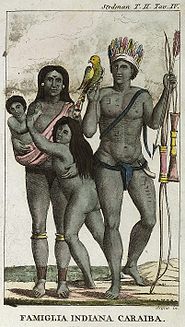
Back كاليناجو ARZ کارائیپلر AZB Карыбы (індзейцы) Byelorussian Karibed Breton Caribs Catalan Карибаш (къаьмнийн тобанаш) CE Karibové Czech Cariber Danish Kariben German Καραΐβοι Greek
 Carib family (by John Gabriel Stedman 1818) | |
| Total population | |
|---|---|
| |
| Regions with significant populations | |
| Dominica, Saint Lucia, Saint Vincent and the Grenadines, and Trinidad and Tobago; formerly throughout the Lesser Antilles | |
| Languages | |
| English, Dominican Creole French, formerly Island Carib | |
| Related ethnic groups | |
| Garifuna (Black Carib), Taíno |

The Kalinago, also called Island Caribs[5] or simply Caribs, are an Indigenous people of the Lesser Antilles in the Caribbean. They may have been related to the Mainland Caribs (Kalina) of South America, but they spoke an unrelated language known as Kalinago or Island Carib. They also spoke a pidgin language associated with the Mainland Caribs.[6]
At the time of Spanish contact, the Kalinago were one of the dominant groups in the Caribbean (the name of which is derived from "Carib", as the Kalinago were once called). They lived throughout north-eastern South America, Trinidad and Tobago, Barbados, the Windward Islands, Dominica, and possibly the southern Leeward Islands. Historically, it was thought their ancestors were mainland peoples who had conquered the islands from their previous inhabitants, the Igneri. However, linguistic and archaeological evidence contradicts the notion of a mass emigration and conquest; the Kalinago language appears not to have been Cariban, but like that of their neighbors, the Taíno. Irving Rouse and others suggest that a smaller group of mainland peoples migrated to the islands without displacing their inhabitants, eventually adopting the local language but retaining their traditions of a South American origin.[7]
In the early colonial period, the Kalinago had a reputation as warriors who raided neighboring islands. According to the tales of Spanish conquistadors, the Kalinago were cannibals who regularly ate roasted human flesh,[8] although this is considered by the community to be an offensive myth. There is no hard evidence of Caribs eating human flesh, though one historian points out it might be useful to frighten enemy Arawak.[9][10] The Kalinago and their descendants continue to live in the Antilles, notably on the island of Dominica. The Garifuna, who share common ancestry with the Kalinago, also live principally in Central America.
- ^ "Dominica's Kalinago fight to preserve their identity". BBC News. 15 July 2018. Archived from the original on 15 September 2021. Retrieved 23 September 2022.
- ^ "World Directory of Minorities and Indigenous Peoples – St Vincent and the Grenadines". refworld. Archived from the original on 4 February 2020. Retrieved 23 September 2022.
- ^ "World Directory of Minorities and Indigenous Peoples – St Lucia". refworld. Archived from the original on 27 June 2017. Retrieved 23 September 2022.
- ^ "World Directory of Minorities and Indigenous Peoples – Trinidad and Tobago". refworld. Archived from the original on 27 May 2021. Retrieved 23 September 2022.
- ^ "Change from Carib to Kalinago now official". Dominica News Online. 2015-02-22. Archived from the original on 2016-03-08. Retrieved 2016-03-03.
- ^ Haurholm-Larsen, Steffen (2016). A Grammar of Garifuna. University of Bern. pp. 7, 8, 9.
- ^ Rouse, Irving (1992). The Tainos. Yale University Press. p. 21. ISBN 0300051816. Retrieved May 22, 2014.
Island Carib.
- ^ Rouse, Irving (1992). The Tainos. Yale University Press. pp. 22–23. ISBN 0300051816. Retrieved May 22, 2014.
- ^ "Study puts the 'Carib' in 'Caribbean,' boosting credibility of Columbus' cannibal claims". 10 January 2020.
- ^ Jennifer, Ouellette (December 29, 2020). "Did Columbus find early Caribs in 15th century Caribbean? Jury is still out". Ars Technica. Archived from the original on February 3, 2024.